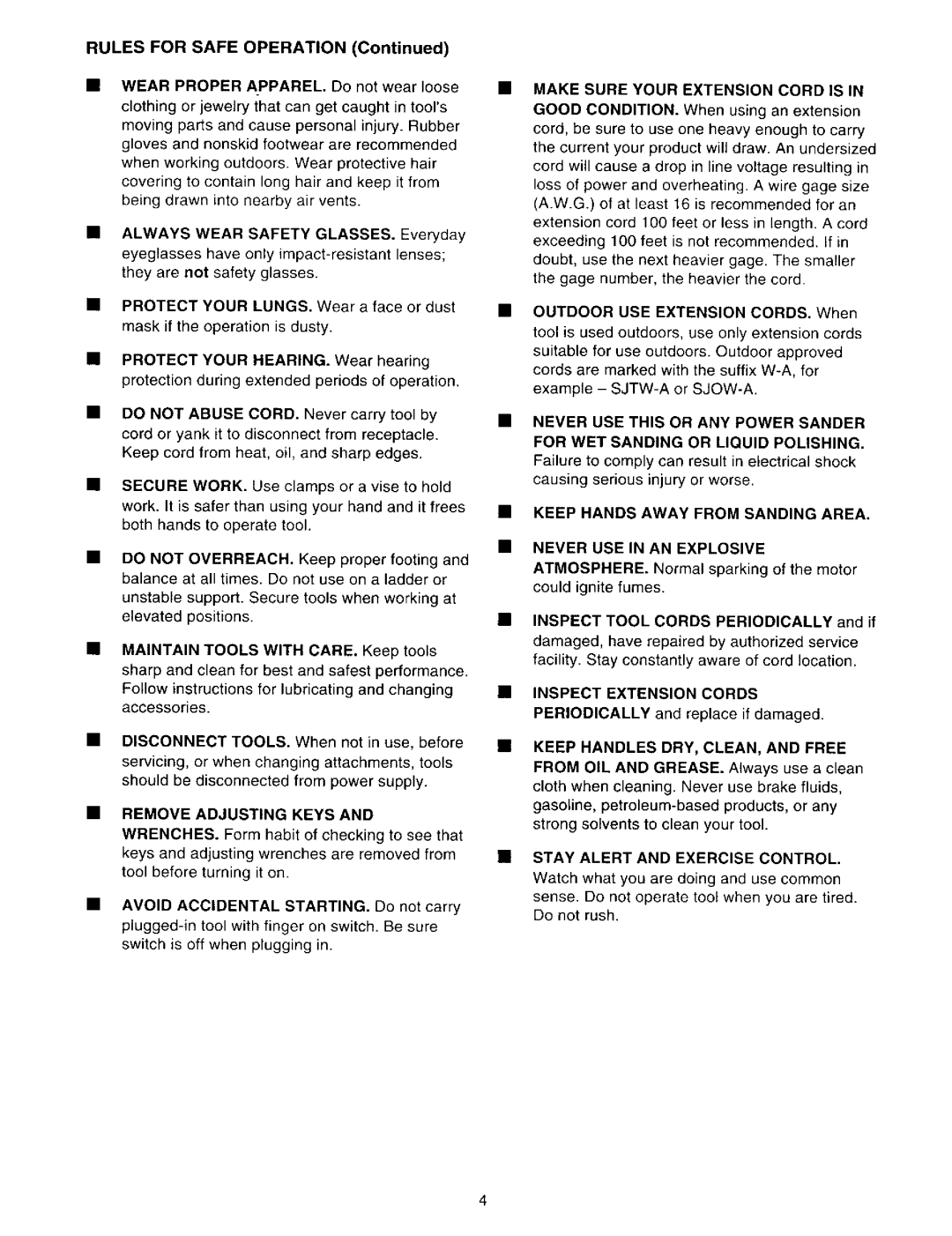
RULES FOR SAFE OPERATION (Continued)
WEAR PROPER APPAREL. Do not wear loose clothing or jewelry that can get caught in tool's moving parts and cause personal injury. Rubber gloves and nonskid footwear are recommended when working outdoors. Wear protective hair covering to contain long hair and keep it from being drawn into nearby air vents.
ALWAYS WEAR SAFETY GLASSES. Everyday eyeglasses have only
PROTECT YOUR LUNGS. Wear a face or dust mask if the operation is dusty.
PROTECT YOUR HEARING. Wear hearing protection during extended periods of operation.
DO NOT ABUSE CORD. Never carry tool by cord or yank it to disconnect from receptacle. Keep cord from heat, oil, and sharp edges.
SECURE WORK. Use clamps or a vise to hold work. It is safer than using your hand and it frees both hands to operate tool.
DO NOT OVERREACH. Keep proper footing and balance at all times. Do not use on a ladder or
unstable support. Secure tools when working at elevated positions.
MAINTAIN TOOLS WITH CARE. Keep tools sharp and clean for best and safest performance. Follow instructions for lubricating and changing accessories.
DISCONNECT TOOLS. When not in use, before servicing, or when changing attachments, tools should be disconnected from power supply.
REMOVE ADJUSTING KEYS AND
WRENCHES. Form habit of checking to see that keys and adjusting wrenches are removed from tool before turning it on.
AVOID ACCIDENTAL STARTING. Do not carry
MAKE SURE YOUR EXTENSION CORD IS IN
GOOD CONDITION. When using an extension cord, be sure to use one heavy enough to carry the current your product will draw. An undersized cord will cause a drop in line voltage resulting in loss of power and overheating. A wire gage size (A.W.G.) of at least 16 is recommended for an extension cord 100 feet or less in length. A cord exceeding 100 feet is not recommended. If in doubt, use the next heavier gage. The smaller the gage number, the heavier the cord
OUTDOOR USE EXTENSION CORDS. When tool is used outdoors, use only extension cords suitable for use outdoors. Outdoor approved cords are marked with the suffix
NEVER USE THIS OR ANY POWER SANDER FOR WET SANDING OR LIQUID POLISHING.
Failure to comply can result in electrical shock
causing serious injury or worse.
KEEP HANDS AWAY FROM SANDING AREA.
NEVER USE IN AN EXPLOSIVE ATMOSPHERE. Normal sparking of the motor could ignite fumes.
INSPECT TOOL CORDS PERIODICALLY and if damaged, have repaired by authorized service facility. Stay constantly aware of cord location.
INSPECT EXTENSION CORDS PERIODICALLY and replace if damaged.
KEEP HANDLES DRY, CLEAN, AND FREE FROM OIL AND GREASE. Always use a clean cloth when cleaning. Never use brake fluids, gasoline,
STAY ALERT AND EXERCISE CONTROL. Watch what you are doing and use common
sense. Do not operate tool when you are tired. Do not rush.
4
